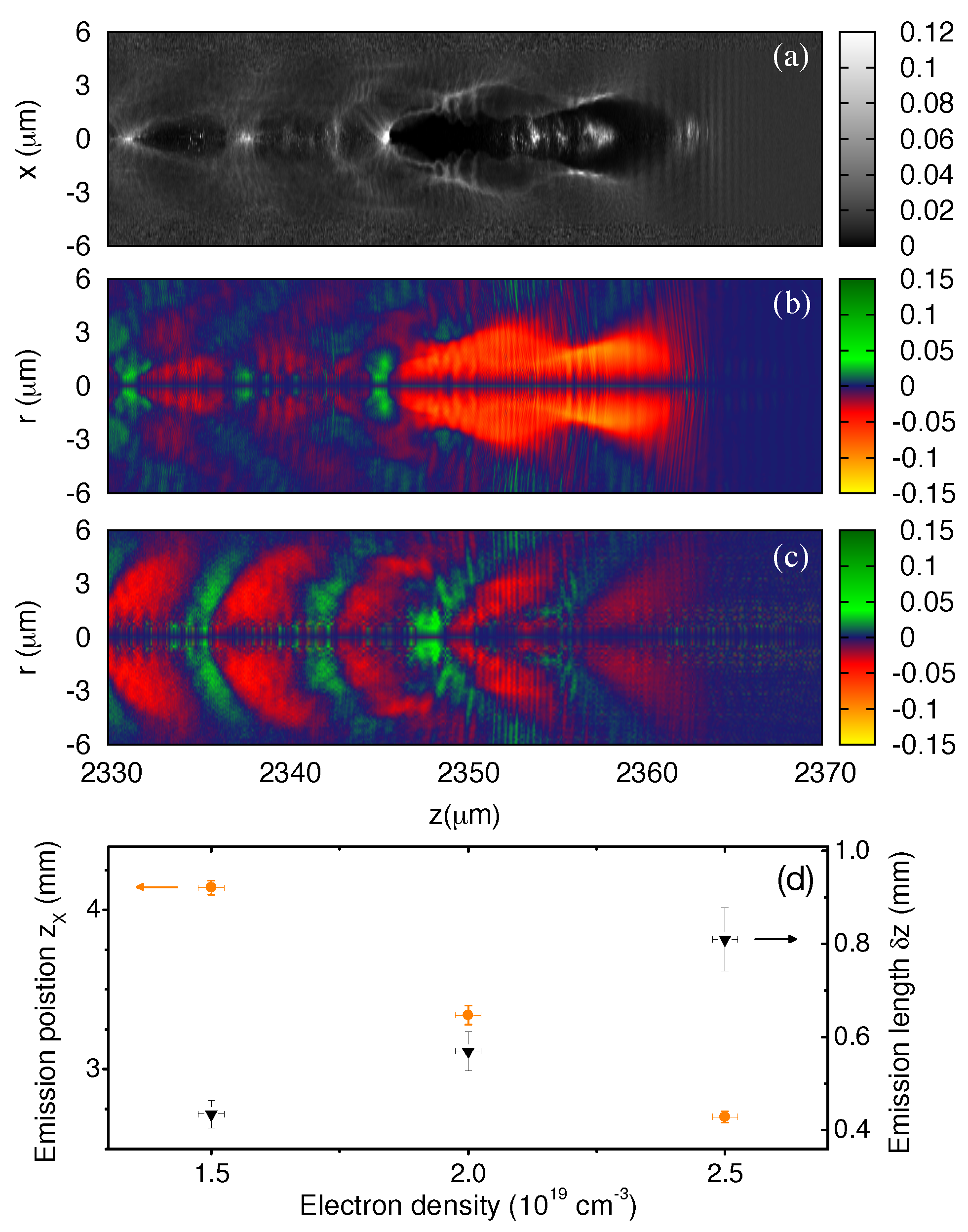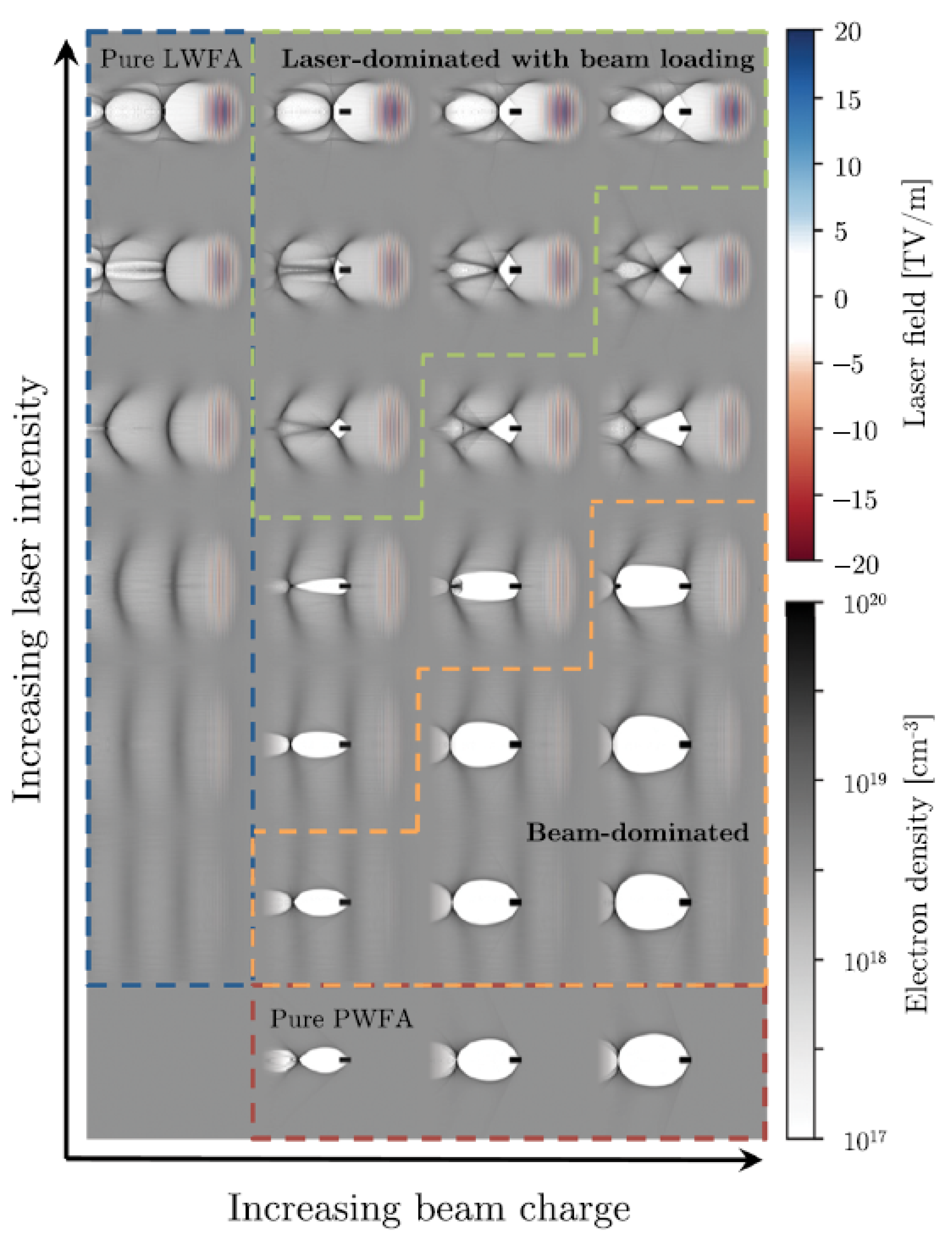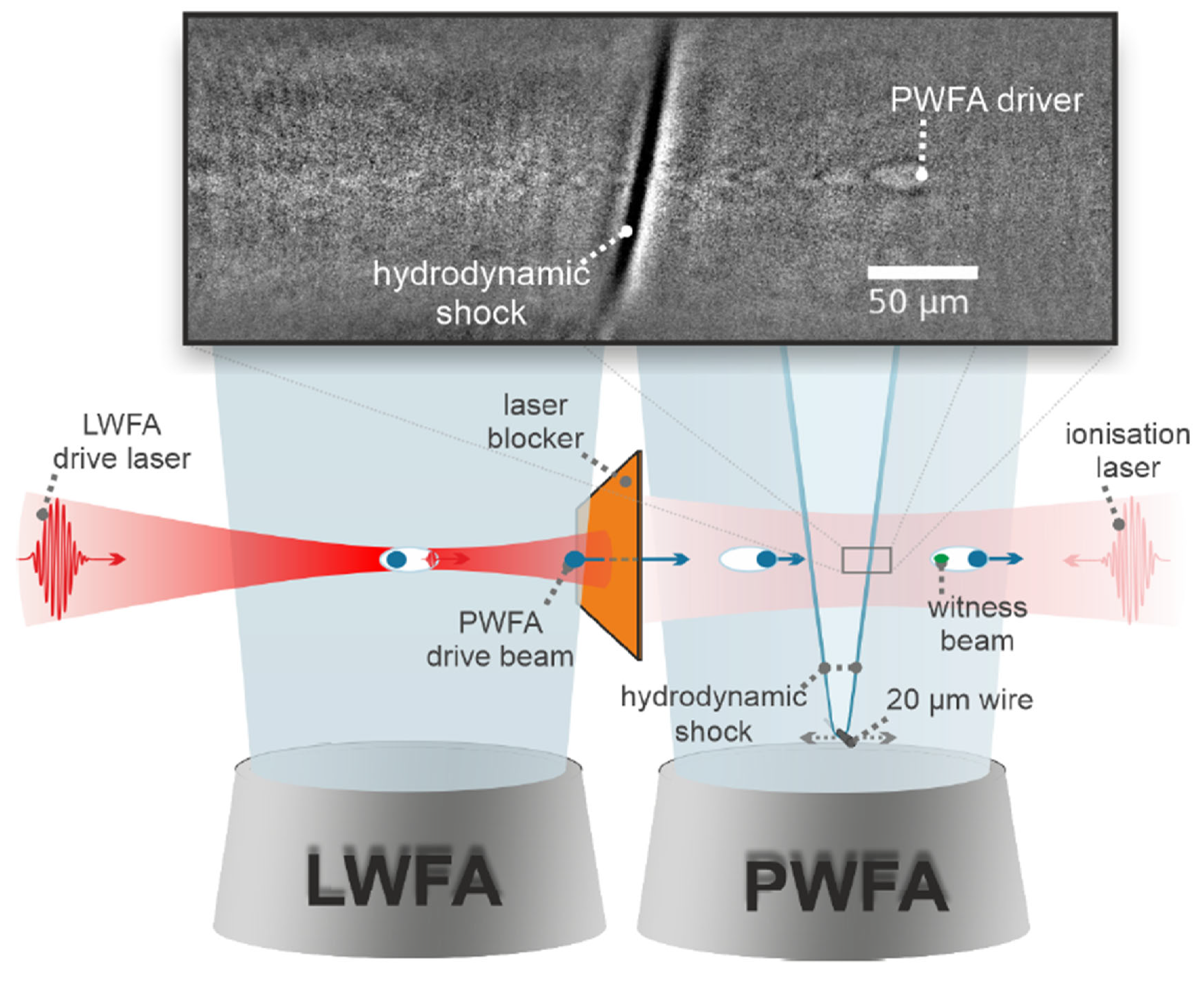Progress in Hybrid Plasma Wakefield Acceleration
Abstract
1. Introduction: LWFA and PWFA
2. Hybrid LWFA→PWFA
3. Full Demonstration of Hybrid LWFA→PWFA
4. Conclusions
Author Contributions
Funding
Institutional Review Board Statement
Informed Consent Statement
Data Availability Statement
Conflicts of Interest
References
- Lawson, J. Collective and coherent methods of particle acceleration. Part. Accel. 1972, 3, 21–33. [Google Scholar]
- Tajima, T.; Dawson, J.M. Laser Electron-Accelerator. Phys. Rev. Lett. 1979, 43, 267–270. [Google Scholar] [CrossRef]
- Chen, P.; Dawson, J.M.; Huff, R.W.; Katsouleas, T. Acceleration of Electrons by the Interaction of a Bunched Electron Beam with a Plasma. Phys. Rev. Lett. 1985, 54, 693–696. [Google Scholar] [CrossRef]
- Strickland, D.; Mourou, G. Compression of amplified chirped optical pulses. Opt. Commun. 1985, 56, 219–221. [Google Scholar] [CrossRef]
- Malka, V.; Faure, J.; Gauduel, Y.A.; Lefebvre, E.; Rousse, A.; Phuoc, K.T. Principles and applications of compact laser-plasma accelerators. Nat. Phys. 2008, 4, 447–453. [Google Scholar] [CrossRef]
- Rosenzweig, J.B. Nonlinear plasma dynamics in the plasma wake-field accelerator. Phys. Rev. Lett. 1987, 58, 555–558. [Google Scholar] [CrossRef] [PubMed]
- Litos, M.; Adli, E.; An, W.; Clarke, C.I.; Clayton, C.E.; Corde, S.; Delahaye, J.P.; England, R.J.; Fisher, A.S.; Frederico, J.; et al. High-efficiency acceleration of an electron beam in a plasma wakefield accelerator. Nature 2014, 515, 92–95. [Google Scholar] [CrossRef] [PubMed]
- Hidding, B.; Koenigstein, T.; Osterholz, J.; Karsch, S.; Willi, O.; Pretzler, G. Monoenergetic Energy Doubling in a Hybrid Laser-Plasma Wakefield Accelerator. Phys. Rev. Lett. 2010, 104, 195002. [Google Scholar] [CrossRef]
- Hidding, B.; Manahan, G.G.; Karger, O.; Knetsch, A.; Wittig, G.; Jaroszynski, D.A.; Sheng, Z.M.; Xi, Y.; Deng, A.; Rosenzweig, J.B.; et al. Ultrahigh brightness bunches from hybrid plasma accelerators as drivers of 5th generation light sources. J. Phys. B At. Mol. Opt. Phys. 2014, 47, 234010. [Google Scholar] [CrossRef]
- Hidding, B.; Beaton, A.; Boulton, L.; Corde, S.; Doepp, A.; Habib, F.A.; Heinemann, T.; Irman, A.; Karsch, S.; Kirwan, G.; et al. Fundamentals and Applications of Hybrid LWFA-PWFA. Appl. Sci. 2019, 9, 2626. [Google Scholar] [CrossRef]
- Gilljohann, M.F.; Ding, H.; Döpp, A.; Götzfried, J.; Schindler, S.; Schilling, G.; Corde, S.; Debus, A.; Heinemann, T.; Hidding, B.; et al. Direct Observation of Plasma Waves and Dynamics Induced by Laser-Accelerated Electron Beams. Phys. Rev. X 2019, 9, 011046. [Google Scholar] [CrossRef]
- Hidding, B.; Foster, B.; Hogan, M.J.; Muggli, P.; Rosenzweig, J.B. Directions in plasma wakefield acceleration. Philos. Trans. R. Soc. A Math. Phys. Eng. Sci. 2019, 377, 20190215. [Google Scholar] [CrossRef]
- Martinez de la Ossa, A.; Assmann, R.W.; Bussmann, M.; Corde, S.; Cabadağ, J.P.C.; Debus, A.; Döpp, A.; Pousa, A.F.; Gilljohann, M.F.; Heinemann, T.; et al. Hybrid LWFA-PWFA staging as a beam energy and brightness transformer: Conceptual design and simulations. Philos. Trans. R. Soc. A Math. Phys. Eng. Sci. 2019, 377, 20180175. [Google Scholar] [CrossRef]
- Manahan, G.G.; Habib, A.F.; Scherkl, P.; Ullmann, D.; Beaton, A.; Sutherland, A.; Kirwan, G.; Delinikolas, P.; Heinemann, T.; Altuijri, R.; et al. Advanced schemes for underdense plasma photocathode wakefield accelerators: Pathways towards ultrahigh brightness electron beams. Philos. Trans. R. Soc. A Math. Phys. Eng. Sci. 2019, 377, 20180182. [Google Scholar] [CrossRef]
- Götzfried, J.; Döpp, A.; Gilljohann, M.F.; Foerster, F.M.; Ding, H.; Schindler, S.; Schilling, G.; Buck, A.; Veisz, L.; Karsch, S. Physics of High-Charge Electron Beams in Laser-Plasma Wakefields. Phys. Rev. X 2020, 10, 041015. [Google Scholar] [CrossRef]
- Pukhov, A.; Meyer-ter Vehn, J. Laser wake field acceleration: The highly non-linear broken-wave regime. Appl. Phys. B-Lasers Opt. 2002, 74, 355–361. [Google Scholar] [CrossRef]
- Rosenzweig, J.B.; Breizman, B.; Katsouleas, T.; Su, J.J. Acceleration and focusing of electrons in two-dimensional nonlinear plasma wake fields. Phys. Rev. A 1991, 44, R6189–R6192. [Google Scholar] [CrossRef]
- Tsung, F.S.; Narang, R.; Mori, W.B.; Joshi, C.; Fonseca, R.A.; Silva, L.O. Near-GeV-Energy Laser-Wakefield Acceleration of Self-Injected Electrons in a Centimeter-Scale Plasma Channel. Phys. Rev. Lett. 2004, 93, 185002. [Google Scholar] [CrossRef] [PubMed]
- Pae, K.H.; Choi, I.W.; Lee, J. Self-mode-transition from laser wakefield accelerator to plasma wakefield accelerator of laser-driven plasma-based electron acceleration. Phys. Plasmas 2010, 17, 123104. [Google Scholar] [CrossRef]
- Corde, S.; Thaury, C.; Phuoc, K.T.; Lifschitz, A.; Lambert, G.; Faure, J.; Lundh, O.; Benveniste, E.; Ben-Ismail, A.; Arantchuk, L.; et al. Mapping the X-ray Emission Region in a Laser-Plasma Accelerator. Phys. Rev. Lett. 2011, 107, 215004. [Google Scholar] [CrossRef] [PubMed]
- Masson-Laborde, P.E.; Mo, M.Z.; Ali, A.; Fourmaux, S.; Lassonde, P.; Kieffer, J.C.; Rozmus, W.; Teychenné, D.; Fedosejevs, R. Giga-electronvolt electrons due to a transition from laser wakefield acceleration to plasma wakefield acceleration. Phys. Plasmas 2014, 21, 123113. [Google Scholar] [CrossRef]
- Heigoldt, M.; Popp, A.; Khrennikov, K.; Wenz, J.; Chou, S.W.; Karsch, S.; Bajlekov, S.I.; Hooker, S.M.; Schmidt, B. Temporal evolution of longitudinal bunch profile in a laser wakefield accelerator. Phys. Rev. ST Accel. Beams 2015, 18, 121302. [Google Scholar] [CrossRef]
- Guillaume, E.; Döpp, A.; Thaury, C.; Lifschitz, A.; Goddet, J.P.; Tafzi, A.; Sylla, F.; Iaquanello, G.; Lefrou, T.; Rousseau, P.; et al. Physics of fully-loaded laser-plasma accelerators. Phys. Rev. ST Accel. Beams 2015, 18, 061301. [Google Scholar] [CrossRef]
- Wu, Y.; Yu, C.; Qin, Z.; Wang, W.; Zhang, Z.; Qi, R.; Feng, K.; Ke, L.; Chen, Y.; Wang, C.; et al. Energy Enhancement and Energy Spread Compression of Electron Beams in a Hybrid Laser-Plasma Wakefield Accelerator. Appl. Sci. 2019, 9, 2561. [Google Scholar] [CrossRef]
- Katsouleas, T.; Wilks, S.; Chen, P.; Dawson, J.; Su, J. Beam loading in Plasma Accelerators. Part. Accel. 1987, 22, 81–99. [Google Scholar]
- Rechatin, C.; Davoine, X.; Lifschitz, A.; Ismail, A.B.; Lim, J.; Lefebvre, E.; Faure, J.; Malka, V. Observation of Beam Loading in a Laser-Plasma Accelerator. Phys. Rev. Lett. 2009, 103, 194804. [Google Scholar] [CrossRef] [PubMed]
- Ke, L.T.; Feng, K.; Wang, W.T.; Qin, Z.Y.; Yu, C.H.; Wu, Y.; Chen, Y.; Qi, R.; Zhang, Z.J.; Xu, Y.; et al. Near-GeV Electron Beams at a Few Per-Mille Level from a Laser Wakefield Accelerator via Density-Tailored Plasma. Phys. Rev. Lett. 2021, 126, 214801. [Google Scholar] [CrossRef]
- Wang, W.; Feng, K.; Ke, L.; Yu, C.; Xu, Y.; Qi, R.; Chen, Y.; Qin, Z.; Zhang, Z.; Fang, M.; et al. Free-electron lasing at 27 nanometres based on a laser wakefield accelerator. Nature 2021, 595, 516–520. [Google Scholar] [CrossRef]
- RadiaBeam: Plasma Photocathode Beam Brightness Transformer for Laser-Plasma-Wakefield Accelerators, DOE DESC0009533, 2013–2016. Available online: https://radiabeam.com/ (accessed on 17 December 2022).
- Deng, A.; Karger, O.; Heinemann, T.; Knetsch, A.; Scherkl, P.; Manahan, G.; Beaton, A.; Ullmann, D.; Wittig, G.; Habib, A.; et al. Generation and acceleration of electron bunches from a plasma photocathode. Nat. Phys. 2019, 15, 1156–1160. [Google Scholar] [CrossRef]
- Hidding, B.; Pretzler, G.; Rosenzweig, J.B.; Königstein, T.; Schiller, D.; Bruhwiler, D.L. Ultracold Electron Bunch Generation via Plasma Photocathode Emission and Acceleration in a Beam-Driven Plasma Blowout. Phys. Rev. Lett. 2012, 108, 035001. [Google Scholar] [CrossRef]
- Chen, P. A possible final focusing mechanism for linear colliders. Part. Accel. 1987, 20, 171–182. [Google Scholar]
- Bennett, W.H. Magnetically Self-Focussing Streams. Phys. Rev. 1934, 45, 890–897. [Google Scholar] [CrossRef]
- Kuschel, S.; Hollatz, D.; Heinemann, T.; Karger, O.; Schwab, M.B.; Ullmann, D.; Knetsch, A.; Seidel, A.; Rödel, C.; Yeung, M.; et al. Demonstration of passive plasma lensing of a laser wakefield accelerated electron bunch. Phys. Rev. Accel. Beams 2016, 19, 071301. [Google Scholar] [CrossRef]
- Thaury, C.; Guillaume, E.; Döpp, A.; Lehe, R.; Lifschitz, A.; Ta Phuoc, K.; Gautier, J.; Goddet, J.P.; Tafzi, A.; Flacco, A.; et al. Demonstration of relativistic electron beam focusing by a laser-plasma lens. Nat. Commun. 2015, 6, 6860. [Google Scholar] [CrossRef]
- Chou, S.; Xu, J.; Khrennikov, K.; Cardenas, D.E.; Wenz, J.; Heigoldt, M.; Hofmann, L.; Veisz, L.; Karsch, S. Collective Deceleration of Laser-Driven Electron Bunches. Phys. Rev. Lett. 2016, 117, 144801. [Google Scholar] [CrossRef] [PubMed]
- Eupraxia: European Plasma Research Accelerator with Excellence in Applications. 2015. Available online: https://roadmap2021.esfri.eu/projects-and-landmarks/browse-the-catalogue/eupraxia/ (accessed on 17 December 2022).
- Sävert, A.; Mangles, S.P.D.; Schnell, M.; Siminos, E.; Cole, J.M.; Leier, M.; Reuter, M.; Schwab, M.B.; Möller, M.; Poder, K.; et al. Direct Observation of the Injection Dynamics of a Laser Wakefield Accelerator Using Few-Femtosecond Shadowgraphy. Phys. Rev. Lett. 2015, 115, 055002. [Google Scholar] [CrossRef]
- D’Arcy, R.; Chappell, J.; Beinortaite, J.; Diederichs, S.; Boyle, G.; Foster, B.; Garland, M.J.; Caminal, P.G.; Lindstrøm, C.A.; Loisch, G.; et al. Recovery time of a plasma-wakefield accelerator. Nature 2022, 603, 58–62. [Google Scholar] [CrossRef]
- Zgadzaj, R.; Li, Z.; Downer, M.; Sosedkin, A.; Khudyakov, V.; Lotov, K.; Silva, T.; Vieira, J.; Allen, J.; Gessner, S.; et al. Dissipation of electron-beam-driven plasma wakes. arXiv 2020, arXiv:2001.09401. [Google Scholar] [CrossRef]
- Scherkl, P.; Knetsch, A.; Heinemann, T.; Sutherland, A.; Habib, A.F.; Karger, O.S.; Ullmann, D.; Beaton, A.; Manahan, G.G.; Xi, Y.; et al. Plasma photonic spatiotemporal synchronization of relativistic electron and laser beams. Phys. Rev. Accel. Beams 2022, 25, 052803. [Google Scholar] [CrossRef]
- Steinke, S.; van Tilborg, J.; Benedetti, C.; Geddes, C.G.R.; Schroeder, C.B.; Daniels, J.; Swanson, K.K.; Gonsalves, A.J.; Nakamura, K.; Matlis, N.H.; et al. Multistage coupling of independent laser-plasma accelerators. Nature 2016, 530, 190–193. [Google Scholar] [CrossRef]
- Raj, G.; Kononenko, O.; Gilljohann, M.F.; Doche, A.; Davoine, X.; Caizergues, C.; Chang, Y.Y.; Couperus Cabadağ, J.P.; Debus, A.; Ding, H.; et al. Probing ultrafast magnetic-field generation by current filamentation instability in femtosecond relativistic laser-matter interactions. Phys. Rev. Res. 2020, 2, 023123. [Google Scholar] [CrossRef]
- Chen, M.; Sheng, Z.M.; Ma, Y.Y.; Zhang, J. Electron injection and trapping in a laser wakefield by field ionization to high-charge states of gases. J. Appl. Phys. 2006, 99, 056109. [Google Scholar] [CrossRef]
- Zeng, M.; Chen, M.; Sheng, Z.M.; Mori, W.B.; Zhang, J. Self-truncated ionization injection and consequent monoenergetic electron bunches in laser wakefield acceleration. Phys. Plasmas 2014, 21, 030701. [Google Scholar] [CrossRef]
- Couperus, J.; Pausch, R.; Köhler, A.; Zarini, O.; Krämer, J.; Garten, M.; Huebl, A.; Gebhardt, R.; Helbig, U.; Bock, S.; et al. Demonstration of a beam loaded nanocoulomb-class laser wakefield accelerator. Nat. Commun. 2017, 8, 487. [Google Scholar] [CrossRef]
- Manahan, G.; Habib, A.; Scherkl, P.; Delinikolas, P.; Beaton, A.; Knetsch, A.; Karger, O.; Wittig, G.; Heinemann, T.; Sheng, Z.; et al. Single-stage plasma-based correlated energy spread compensation for ultrahigh 6D brightness electron beams. Nat. Commun. 2017, 8, 15705. [Google Scholar] [CrossRef]
- Kurz, T.; Heinemann, T.; Gilljohann, M.F.; Chang, Y.Y.; Couperus Cabadağ, J.P.; Debus, A.; Kononenko, O.; Pausch, R.; Schöbel, S.; Assmann, R.W.; et al. Demonstration of a compact plasma accelerator powered by laser-accelerated electron beams. Nat. Commun. 2021, 12, 2895. [Google Scholar] [CrossRef]
- Corde, S.; Adli, E.; Allen, J.M.; An, W.; Clarke, C.I.; Clausse, B.; Clayton, C.E.; Delahaye, J.P.; Frederico, J.; Gessner, S.; et al. High-field plasma acceleration in a high-ionization-potential gas. Nat. Commun. 2016, 7, 11898. [Google Scholar] [CrossRef]
- Couperus Cabadağ, J.P.; Pausch, R.; Schöbel, S.; Bussmann, M.; Chang, Y.Y.; Corde, S.; Debus, A.; Ding, H.; Döpp, A.; Foerster, F.M.; et al. Gas-dynamic density downramp injection in a beam-driven plasma wakefield accelerator. Phys. Rev. Res. 2021, 3, L042005. [Google Scholar] [CrossRef]
- Schöbel, S.; Pausch, R.; Chang, Y.Y.; Corde, S.; Cabadağ, J.C.; Debus, A.; Ding, H.; Döpp, A.; Foerster, F.M.; Gilljohann, M.; et al. Effect of driver charge on wakefield characteristics in a plasma accelerator probed by femtosecond shadowgraphy. New J. Phys. 2022, 24, 083034. [Google Scholar] [CrossRef]
- Foerster, F.M.; Döpp, A.; Haberstroh, F.; Grafenstein, K.v.; Campbell, D.; Chang, Y.Y.; Corde, S.; Couperus Cabadağ, J.P.; Debus, A.; Gilljohann, M.F.; et al. Stable and High-Quality Electron Beams from Staged Laser and Plasma Wakefield Accelerators. Phys. Rev. X 2022, 12, 041016. [Google Scholar] [CrossRef]
- Ullmann, D.; Scherkl, P.; Knetsch, A.; Heinemann, T.; Sutherland, A.; Habib, A.F.; Karger, O.S.; Beaton, A.; Manahan, G.G.; Deng, A.; et al. All-optical density downramp injection in electron-driven plasma wakefield accelerators. arXiv 2020, arXiv:2007.12634. [Google Scholar] [CrossRef]
- Knetsch, A.; Sheeran, B.; Boulton, L.; Niknejadi, P.; Põder, K.; Schaper, L.; Zeng, M.; Bohlen, S.; Boyle, G.; Brümmer, T.; et al. Stable witness-beam formation in a beam-driven plasma cathode. Phys. Rev. Accel. Beams 2021, 24, 101302. [Google Scholar] [CrossRef]
- Habib, A.F.; Scherkl, P.; Manahan, G.G.; Heinemann, T.; Ullmann, D.; Sutherland, A.; Knetsch, A.; Litos, M.; Hogan, M.; Rosenzweig, J.; et al. Plasma accelerator-based ultrabright X-ray beams from ultrabright electron beams. In Proceedings of the Advances in Laboratory-Based X-ray Sources, Optics, and Applications VII, San Diego, CA, USA, 13 August 2019; International Society for Optics and Photonics: Bellingham, WA, USA, 2019; Volume 11110, p. 111100A. [Google Scholar]
- Emma, C.; Van Tilborg, J.; Assmann, R.; Barber, S.; Cianchi, A.; Corde, S.; Couprie, M.E.; D’Arcy, R.; Ferrario, M.; Habib, A.F.; et al. Free electron lasers driven by plasma accelerators: Status and near-term prospects. High Power Laser Sci. Eng. 2021, 9, e57. [Google Scholar] [CrossRef]
- Ferri, J.; Corde, S.; Döpp, A.; Lifschitz, A.; Doche, A.; Thaury, C.; Ta Phuoc, K.; Mahieu, B.; Andriyash, I.A.; Malka, V.; et al. High-Brilliance Betatron γ-Ray Source Powered by Laser-Accelerated Electrons. Phys. Rev. Lett. 2018, 120, 254802. [Google Scholar] [CrossRef]
- Pompili, R.; Alesini, D.; Anania, M.P.; Arjmand, S.; Behtouei, M.; Bellaveglia, M.; Biagioni, A.; Buonomo, B.; Cardelli, F.; Carpanese, M.; et al. Free-electron lasing with compact beam-driven plasma wakefield accelerator. Nature 2022, 605, 659–662. [Google Scholar] [CrossRef]
- Labat, M.; Cabadağ, J.C.; Ghaith, A.; Irman, A.; Berlioux, A.; Berteaud, P.; Blache, F.; Bock, S.; Bouvet, F.; Briquez, F.; et al. Seeded free-electron laser driven by a compact laser plasma accelerator. Nat. Photonics 2022, 1–7. [Google Scholar] [CrossRef]
- Habib, A.F.; Manahan, G.; Scherkl, P.; Heinemann, T.; Sutherland, A.; Altuiri, R.; Alotaibi, B.M.; Litos, M.; Cary, J.; Raubenheimer, T.; et al. Attosecond-Angstrom free-electron-laser towards the cold beam limit. arXiv 2022, arXiv:2212.04398. [Google Scholar]











Disclaimer/Publisher’s Note: The statements, opinions and data contained in all publications are solely those of the individual author(s) and contributor(s) and not of MDPI and/or the editor(s). MDPI and/or the editor(s) disclaim responsibility for any injury to people or property resulting from any ideas, methods, instructions or products referred to in the content. |
© 2023 by the authors. Licensee MDPI, Basel, Switzerland. This article is an open access article distributed under the terms and conditions of the Creative Commons Attribution (CC BY) license (https://creativecommons.org/licenses/by/4.0/).
Share and Cite
Hidding, B.; Assmann, R.; Bussmann, M.; Campbell, D.; Chang, Y.-Y.; Corde, S.; Cabadağ, J.C.; Debus, A.; Döpp, A.; Gilljohann, M.; et al. Progress in Hybrid Plasma Wakefield Acceleration. Photonics 2023, 10, 99. https://doi.org/10.3390/photonics10020099
Hidding B, Assmann R, Bussmann M, Campbell D, Chang Y-Y, Corde S, Cabadağ JC, Debus A, Döpp A, Gilljohann M, et al. Progress in Hybrid Plasma Wakefield Acceleration. Photonics. 2023; 10(2):99. https://doi.org/10.3390/photonics10020099
Chicago/Turabian StyleHidding, Bernhard, Ralph Assmann, Michael Bussmann, David Campbell, Yen-Yu Chang, Sébastien Corde, Jurjen Couperus Cabadağ, Alexander Debus, Andreas Döpp, Max Gilljohann, and et al. 2023. "Progress in Hybrid Plasma Wakefield Acceleration" Photonics 10, no. 2: 99. https://doi.org/10.3390/photonics10020099
APA StyleHidding, B., Assmann, R., Bussmann, M., Campbell, D., Chang, Y.-Y., Corde, S., Cabadağ, J. C., Debus, A., Döpp, A., Gilljohann, M., Götzfried, J., Foerster, F. M., Haberstroh, F., Habib, F., Heinemann, T., Hollatz, D., Irman, A., Kaluza, M., Karsch, S., ... Zepf, M. (2023). Progress in Hybrid Plasma Wakefield Acceleration. Photonics, 10(2), 99. https://doi.org/10.3390/photonics10020099





